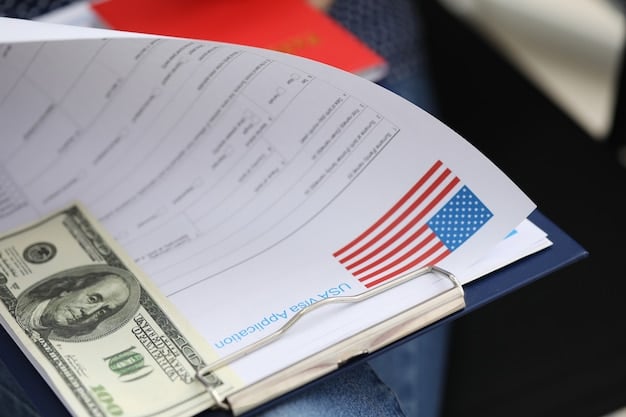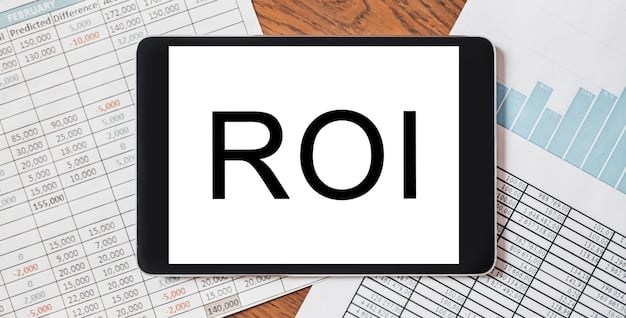Understanding the New IRS Guidelines for Charitable Donations in 2025

Understanding the New IRS Guidelines for Tax Deductions on Charitable Donations in 2025 is crucial for US taxpayers seeking to maximize their deductions while adhering to updated regulations set forth by the IRS, ensuring accurate and beneficial charitable giving strategies.
Navigating the complexities of tax deductions can be daunting, especially when it comes to charitable donations. This article aims to provide clear understanding the new IRS guidelines for tax deductions on charitable donations in 2025 enabling you to make informed decisions and maximize your tax benefits while supporting worthy causes.
Decoding the 2025 IRS Charitable Donation Guidelines
The IRS updates its guidelines periodically, and 2025 is no exception. It’s essential to stay informed about these changes to ensure compliance and optimize your tax deductions. These guidelines dictate what donations qualify, how to value them, and what documentation is needed.
These changes often reflect broader shifts in tax law, economic conditions, and societal priorities. By understanding these factors, taxpayers can be better prepared to navigate the complexities of charitable giving and tax planning.
Key Changes in Deduction Rules
Several changes could affect how you deduct charitable donations. For 2025, look out for adjustments to the standard deduction, which might influence whether itemizing is beneficial. Also check for any modifications to the AGI (Adjusted Gross Income) limits for deductions.
- Keep an eye on any changes to the definition of qualifying organizations.
- Understand how to handle donations of property, which have specific valuation rules.
- Be aware of any new or revised record-keeping requirements.
Staying updated with these key changes ensures that your charitable contributions align with IRS requirements, maximizing your potential tax benefits. It’s also important to consult with a tax professional to address specific circumstances.
Who Qualifies as a Charitable Organization Under IRS Rules?
Not every organization qualifies for tax-deductible donations. To be eligible, an organization must be recognized by the IRS as a 501(c)(3) entity. This status indicates that the organization is operated for religious, charitable, scientific, or educational purposes.
Confirming this status is important because donations to non-qualified organizations cannot be claimed as deductions on your tax return. Always verify before donating to ensure compliance and maximize tax benefits.
How to Verify an Organization’s Status
The IRS provides a tool called the “Tax Exempt Organization Search” on its website. This database allows you to search for organizations and confirm their 501(c)(3) status. Simply enter the organization’s name to verify its eligibility.
- Use the IRS’s online search tool to confirm 501(c)(3) status.
- Look for the charity’s EIN (Employer Identification Number) on their website.
- If unsure, contact the organization directly and ask for confirmation.
Always double-check the organization’s eligibility before making a donation. This practice protects your tax benefits and ensures that your contributions support legitimate and IRS-approved charitable endeavors.

What Types of Donations Are Tax-Deductible?
Understanding which types of donations are tax-deductible is vital. Cash donations, property donations, and even certain volunteer expenses can qualify, but each comes with its own set of rules and limitations.
What often qualifies for donations are tangible assets, even certain volunteer expenses. Knowing more about these rules could help with your tax deductions greatly.
Cash vs. Non-Cash Donations
Cash donations are straightforward: you can deduct the amount of cash you donated. Non-cash donations, however, require valuation. For items like clothing or household goods, you can generally deduct the fair market value.
For property donations, such as stocks or real estate, the rules can be more complex. Consult IRS guidelines or a tax professional to ensure you are accurately valuing these donations.
- Cash donations are deductible up to certain AGI limits.
- Non-cash donations require valuation and proper documentation.
- Property donations have specific rules based on asset type and value.
Different forms of donations have unique tax implications. Knowing the exact specifics of each form can lead to optimized tax deductions and maximized savings overall.
How to Value Non-Cash Donations for Tax Purposes
Valuing non-cash donations correctly is crucial to avoid issues with the IRS. The fair market value is generally used, but the rules vary depending on the type of property and its value.
Under IRS rules, it is not appropriate to claim “what you paid for it” originally, and instead provide fair market value given the condition of the item.
Fair Market Value Explained
Fair market value is the price a willing buyer would pay a willing seller. For small items like used clothing, this might be the price you would find at a thrift store. For larger items like vehicles or artwork, you might need a professional appraisal.
Donations of property valued over \$5,000 often require a qualified appraisal to substantiate the deduction. Failure to obtain a proper valuation can result in penalties or disallowed deductions.

- Fair market value is what a willing buyer would pay.
- For items over \$5,000, a qualified appraisal is often required.
- Keep records of how you determined the value of non-cash donations.
Accurate valuations are necessary to ensure tax compliance. Make sure to understand how these valuations are calculated for the benefit of your tax deductions.
Record-Keeping Requirements for Charitable Donations
Maintaining proper records is non-negotiable when claiming charitable donation deductions. The IRS requires specific documentation to support your claims, and the requirements vary depending on the donation’s value.
Maintaining these records will help to avoid penalties and maximize your tax savings. Always prepare thoroughly, and keep documentation in a safe location.
What Documentation Do You Need?
For cash donations, you’ll need a bank record or a written communication from the charity showing the name of the organization, the date, and the amount. For non-cash donations, you’ll need a receipt from the charity if the donation is over \$250.
For donations of property valued at more than \$500, you must also complete Form 8283, Noncash Charitable Contributions, and attach it to your tax return. For donations over \$5,000, a qualified appraisal is usually required.
- Keep bank records or written communications for cash donations.
- Obtain receipts from charities for non-cash donations over \$250.
- File Form 8283 for property donations over \$500.
The IRS needs solid evidence of every tax deduction claimed. Keeping documentation for taxes is essential in maximizing savings and benefits, while remaining in compliance.
Common Mistakes to Avoid When Claiming Deductions
Many taxpayers make easily avoidable mistakes when claiming charitable donation deductions. Being aware of these common pitfalls can help you steer clear of issues with the IRS and maximize your tax benefits.
Avoiding these common mistakes will help you optimize your tax benefits and comply with IRS regulations. Stay educated and take care to ensure accurate deductions.
Not Verifying Charity Status
One of the most common errors is claiming deductions for donations made to organizations that are not IRS-recognized 501(c)(3) entities. Always verify the charity’s status using the IRS’s online tool before making a donation.
Overvaluing Non-Cash Donations
Another frequent mistake is overvaluing non-cash donations. Remember to use fair market value and obtain a qualified appraisal when needed. Relying on inflated values can trigger an audit.
- Always verify the charity’s 501(c)(3) status.
- Value non-cash donations accurately using fair market value.
- Maintain thorough records of all donations, regardless of amount.
Staying informed and organized can significantly reduce the risk of errors when claiming deductions. Stay educated and prepared to ensure that deductions are claimed while staying in compliance.
| Key Aspect | Brief Description |
|---|---|
| ✅ Charity Status | Verify the organization’s 501(c)(3) status with the IRS. |
| 💰 Donation Types | Cash, property, and volunteer expenses may be deductible. |
| 🧾 Record Keeping | Maintain bank records, receipts, and Form 8283 for deductions. |
| 📊 Valuation | Use fair market value and obtain appraisals for high-value items. |
FAQ
▼
A 501(c)(3) organization is a non-profit corporation recognized by the IRS as tax-exempt because it is operated for religious, charitable, scientific, or educational purposes.
▼
You can verify an organization’s status using the IRS’s Tax Exempt Organization Search tool on their website. This tool allows you to search for organizations and confirm their eligibility.
▼
For cash donations, you need a bank record or a written communication from the charity showing the name of the organization, the date, and the amount of the contribution.
▼
Fair market value is the price a willing buyer would pay a willing seller for the item. For small items, this might be thrift store prices. Larger items might require a professional appraisal.
▼
You must file Form 8283, Noncash Charitable Contributions, for donations of property valued at more than \$500. Attach it to your tax return when you claim the deduction.
Conclusion
Understanding the intricacies of the IRS guidelines for tax deductions on charitable donations in 2025 is essential for maximizing tax benefits while staying compliant. By verifying charity status, understanding donation types, and diligently keeping records, taxpayers can effectively navigate the complexities of charitable giving and optimize their financial strategies.





